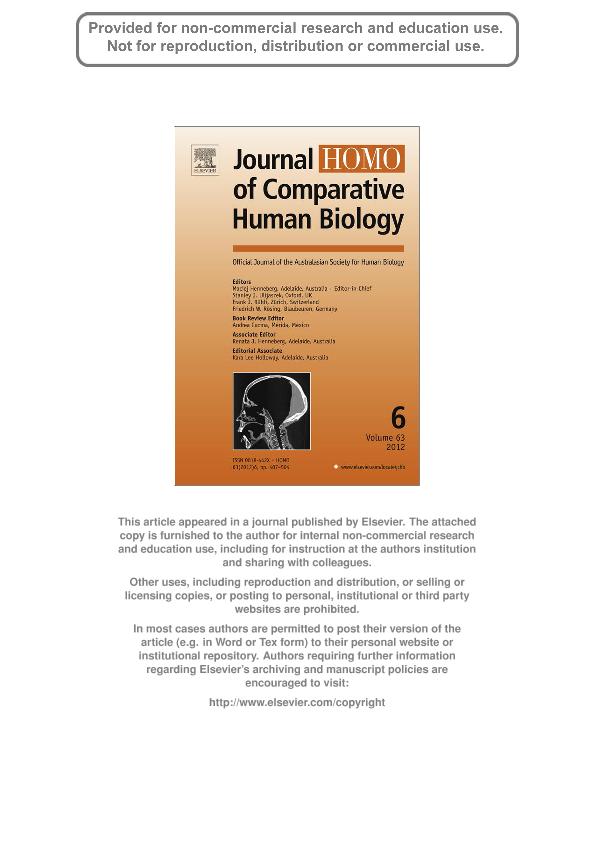Mostrar el registro sencillo del ítem
dc.contributor.author
Bosio, L. A.
dc.contributor.author
García Guraieb, S.
dc.contributor.author
Luna, Leandro Hernan

dc.contributor.author
Aranda, C.
dc.date.available
2023-05-17T11:14:15Z
dc.date.issued
2012-10
dc.identifier.citation
Bosio, L. A.; García Guraieb, S.; Luna, Leandro Hernan; Aranda, C.; Chacarita Project: Conformation and analysis of a modern and documented human osteological collection from Buenos Aires City - Theoretical, methodological and ethical aspects; Elsevier; Homo; 63; 6; 10-2012; 481-492
dc.identifier.issn
0018-442X
dc.identifier.uri
http://hdl.handle.net/11336/197761
dc.description.abstract
Osteological reference collections play a key role in bioanthropological research; they allow the development and testing of methods for sexing and aging individuals using different bone and dental attributes. This paper presents the first stage results of the ongoing Chacarita Research Project, which aims to generate and study a reference collection of adult skeletons representative of the contemporary population of Buenos Aires city. The Chacarita Collection is being conformed of unclaimed human remains of individuals of known nationality, sex, age, cause and date of death from the Chacarita Public Cemetery. Unlike other similar endeavors, this sample has been completely exhumed using archaeological techniques. So far, a total of 146 adult skeletons have been recovered (60 females - 41.1% - and 86 males - 58.90% -), the majority of which have ages-at-death in the range of 71-90 years. They were born primarily in Argentina (n = 133; 91.1%), although other nationalities are also represented. Dates of death go between 1987 and 2000. In the short term, the osteological study of this collection will allow assessment of the performance of classical methods of sex determination and age-at-death estimation in a local setting. A special priority will be given to the study of osteological changes in individuals over 50 years. As the sample is being retrieved by exhumation, the impact of taphonomic agents on the most diagnostic bones structures is also being assessed. In the long term, this osteological collection will be available to generate new population-specific techniques, and to develop comparative biological studies.
dc.format
application/pdf
dc.language.iso
eng
dc.publisher
Elsevier

dc.rights
info:eu-repo/semantics/openAccess
dc.rights.uri
https://creativecommons.org/licenses/by-nc-sa/2.5/ar/
dc.subject
Antropología forense
dc.subject
Bioarqueología
dc.subject
Colección de referencia
dc.subject
Ética
dc.subject.classification
Arqueología

dc.subject.classification
Historia y Arqueología

dc.subject.classification
HUMANIDADES

dc.title
Chacarita Project: Conformation and analysis of a modern and documented human osteological collection from Buenos Aires City - Theoretical, methodological and ethical aspects
dc.type
info:eu-repo/semantics/article
dc.type
info:ar-repo/semantics/artículo
dc.type
info:eu-repo/semantics/publishedVersion
dc.date.updated
2023-05-16T14:43:33Z
dc.journal.volume
63
dc.journal.number
6
dc.journal.pagination
481-492
dc.journal.pais
Estados Unidos

dc.journal.ciudad
Nueva York
dc.description.fil
Fil: Bosio, L. A.. Universidad de Buenos Aires. Facultad de Medicina. Cátedra de Medicina Legal y Deontología Médica. Servicio de Antropología Forense; Argentina
dc.description.fil
Fil: García Guraieb, S.. Secretaría de Cultura de la Nación. Dirección Nacional de Cultura y Museos. Instituto Nacional de Antropología y Pensamiento Latinoamericano; Argentina
dc.description.fil
Fil: Luna, Leandro Hernan. Universidad de Buenos Aires. Facultad de Filosofía y Letras. Museo Etnográfico "Juan B. Ambrosetti"; Argentina. Consejo Nacional de Investigaciones Científicas y Técnicas; Argentina
dc.description.fil
Fil: Aranda, C.. Universidad de Buenos Aires. Facultad de Filosofía y Letras. Museo Etnográfico "Juan B. Ambrosetti"; Argentina
dc.journal.title
Homo
dc.relation.alternativeid
info:eu-repo/semantics/altIdentifier/url/https://www.sciencedirect.com/science/article/abs/pii/S0018442X12000947
dc.relation.alternativeid
info:eu-repo/semantics/altIdentifier/doi/http://dx.doi.org/10.1016/j.jchb.2012.06.003
Archivos asociados
